
Maryborough Courthouse is a heritage-listed courthouse at 170 Richmond Street, Maryborough, Fraser Coast Region, Queensland, Australia. It was designed by Francis Drummond Greville Stanley and built in 1877 by John Thomas Annear for the Queensland Government. It is also known as Maryborough Court House and Government Offices. It was added to the Queensland Heritage Register on 21 October 1992.
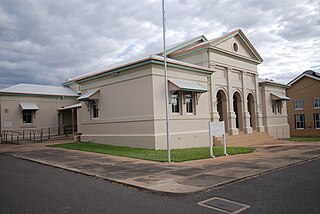
Charters Towers Courthouse is a heritage-listed courthouse at 28 Hodgkinson Street, Charters Towers City, Charters Towers, Charters Towers Region, Queensland, Australia. It was designed by John James Clark and built in 1886 by Charles Miller. It is also known as Charters Towers Courthouse. It was added to the Queensland Heritage Register on 21 October 1992.
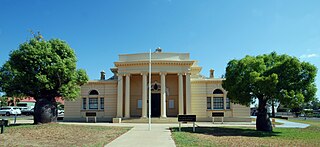
Roma Courthouse is a heritage-listed courthouse at 141 McDowall Street, Roma, Maranoa Region, Queensland, Australia. Constructed in 1901, the courthouse is a rendered masonry building, which is still in use today. Predominately influenced by the Federation free style, it is considered a stunning example of Federation colonial architecture at its best. It is also known as Roma Court House and Roma Police Buildings. It was added to the Queensland Heritage Register on 7 August 1998.

Cardwell Bush Telegraph is a heritage-listed former post office and now heritage centre at 53 Victoria Street, Cardwell, Cassowary Coast Region, Queensland, Australia. The Telegraph and Post Office at Cardwell was designed by Colonial Architect's Office and built in 1870 by George McCallum, making it one of the oldest buildings in North Queensland.

The Old Cleveland Police Station is a heritage-listed police station at 1 Passage Street, Cleveland, City of Redland, Queensland, Australia. It was built from 1934 to 1935. It was added to the Queensland Heritage Register on 26 March 1999.

Gympie Lands Office is a heritage-listed former court house and public administration building at 26 Channon Street, Gympie, Queensland, Australia. It was designed by Queensland Department of Public Works and Queensland Colonial Architect's Office and built in 1942 by the Department of Public Works, Gympie City Council, Mark Doggett, Andrew Collins, and George Caldwell. It was added to the Queensland Heritage Register on 15 July 2011.

Rockhampton Courthouse is a heritage-listed courthouse at 42 East Street, Rockhampton, Rockhampton Region, Queensland, Australia. It was designed by John Hitch and built from 1950 to 1955. It is also known as District Court, Queensland Government Savings Bank, Commonwealth Bank, Magistrate's Court, Police Court, and Supreme Court. It was added to the Queensland Heritage Register on 21 October 1992.

Maryborough Government Offices Building is a heritage-listed office building at 123 Wharf Street, Maryborough, Fraser Coast Region, Queensland, Australia. It was designed by Gilbert Robert Beveridge and Raymond Clare Nowland and built in 1940 by relief work. It is also known as State Government Insurance Offices and State Government Offices. It was added to the Queensland Heritage Register on 21 October 1992.
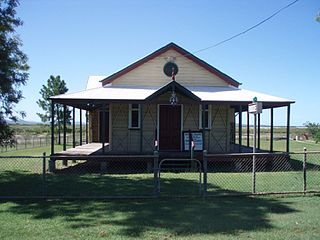
St Lawrence Police Station is a heritage-listed police station and former courthouse at Macartney Street, St Lawrence, Isaac Region, Queensland, Australia. It was built from 1878 to 1934. It is also known as former St Lawrence Courthouse and Cell Block. It was added to the Queensland Heritage Register on 24 November 2000.

Mackay Court House and Police Station is a heritage-listed courthouse and police station at 67 Victoria Street and 14 Brisbane Street, Mackay, Mackay Region, Queensland, Australia. They were built from 1886 to 1963. It is also known as Mackay Court House and Mackay Police Station. It was added to the Queensland Heritage Register on 21 October 1992.

Burdekin Shire Council Chambers is a heritage-listed town hall at 145 Young Street, Ayr, Shire of Burdekin, Queensland, Australia. It was designed by Frederick Smith and built in 1937 by local builder AS Wight. It is also known as Ayr Shire Council Chambers. It was added to the Queensland Heritage Register on 13 October 1997.

Townsville Customs House is a heritage-listed former customs house at Wickham Street, Townsville CBD, City of Townsville, Queensland, Australia. It was designed by George David Payne and built from 1900 to 1902 by Crawford & Cameron. It was added to the Queensland Heritage Register on 7 February 2005.

Townsville School of Arts is a heritage-listed former school of arts and now community cultural centre at Stanley Street, Townsville CBD, City of Townsville, Queensland, Australia. It was designed by Eyre & Munro and built in 1891 by James Smith. It is also known as Dancenorth Theatre and Townsville Arts Centre. It was added to the Queensland Heritage Register on 21 October 1992.

Bank of New South Wales Building is a former heritage-listed bank at 101–111 Flinders Street, Townsville CBD, City of Townsville, Queensland, Australia. It was built in 1887 by Denis Kelleher. It is also known as Australian Meat Industry Employees Union. It was added to the Queensland Heritage Register on 21 October 1992.

Townsville Magistrates Court is a heritage-listed former courthouse and now theatre at 81 Sturt Street, Townsville CBD, City of Townsville, Queensland, Australia. It was designed by Francis Drummond Greville Stanley and built from 1874 to 1876 by J & J Rooney. It is also known as Townsville Court House and Townsville Museum. It was added to the Queensland Heritage Register on 21 October 1992.

Drystone Wall is a heritage-listed drystone wall at 2-4 Cleveland Terrace, Townsville CBD, City of Townsville, Queensland, Australia. It was built in 1877. It is also known as Queensland Transport, Townsville Library and School of Arts/Licence Testing Centre, and Townsville Supreme Court. It was added to the Queensland Heritage Register on 7 February 2005.

Cairns Court House Complex is a heritage-listed site incorporating a former courthouse and a former public administration building at 38–40 Abbott Street, Cairns City, Cairns, Cairns Region, Queensland, Australia. It was built from 1919 to 1921. It was added to the Queensland Heritage Register on 21 October 1992.
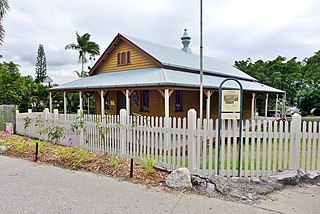
Port Douglas Court House Museum is a heritage-listed former courthouse and now museum at 25 Wharf Street, Port Douglas, Shire of Douglas, Queensland, Australia. It was designed by the Queensland Colonial Architect's Office and built from 1879 by Thomas Watson. It was formerly known as Port Douglas Court House. It was added to the Queensland Heritage Register on 21 October 1992. The museum is operated by the Port Douglas Historical Society.

Bowen Post Office is a heritage-listed post office at 46 Herbert Street, Bowen, Queensland, Australia. It was designed by the Commonwealth Department of the Interior and constructed in 1936. It was added to the Australian Commonwealth Heritage List on 8 November 2011.
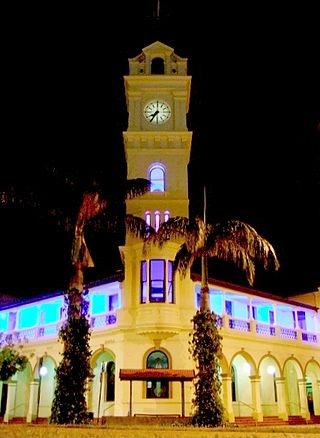
Bundaberg Post Office is a heritage-listed post office at 155a Bourbong Street, Bundaberg Central, Bundaberg, Bundaberg Region, Queensland, Australia. It was added to the Australian Commonwealth Heritage List on 8 November 2011.






















